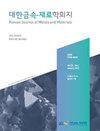The Mechanism behind the High Thermoelectric Performance in YbCd2-xMgxSb2
IF 1.4
4区 材料科学
Q4 MATERIALS SCIENCE, MULTIDISCIPLINARY
引用次数: 0
Abstract
YbCd2Sb2 is a promising Zintl compound for waste heat recovery applications due to its low thermal conductivity, originating from its complex crystal structure. Many strategies such as alloying or doping have been suggested to further reduce the thermal conductivity of YbCd2Sb2 to improve its thermoelectric performance. However, the effects of alloying or doping on the electronic transport properties of YbCd2Sb2 have not been evaluated in detail. Here, previously reported thermoelectric properties of YbCd2-xMgxSb2 (x = 0, 0.2, 0.4) with drastic thermal conductivity suppression were evaluated using the Single Parabolic Band (SPB) model and Callaway von Bayer (CvB) model. The SPB and CvB models evaluate any changes in electronic band parameters and phonon scattering strength, respectively, due to Mg alloying. Based on the SPB model, Mg alloying deteriorated the weighted mobility, mostly due to non-degenerate mobility reduction. However, the magnitude of point-defect phonon scattering significantly increased with Mg alloying, as evaluated by the CvB model. As a result, the maximum zT is achieved when x = 0.4 at 700 K despite the decreased electronic transport properties from Mg alloying. Our work suggests that carefully designed alloying can improve the thermoelectric performance of the Zintl compound even when it changes its electronic and thermal transport properties in opposite directions.YbCd2-xMgxSb2高热电性能的机理
YbCd2Sb2由于其复杂的晶体结构而具有低导热性,是一种很有前途的废热回收Zintl化合物。为了进一步降低YbCd2Sb2的导热系数,提高其热电性能,人们提出了合金化或掺杂等多种策略。然而,合金化或掺杂对YbCd2Sb2电子输运性质的影响尚未得到详细的评价。本文采用单抛物带(SPB)模型和Callaway von Bayer (CvB)模型对先前报道的具有剧烈导热抑制的YbCd2-xMgxSb2 (x = 0,0.2, 0.4)的热电性能进行了评估。SPB和CvB模型分别评估了Mg合金化对电子带参数和声子散射强度的影响。基于SPB模型,Mg合金恶化了合金的加权迁移率,主要是由于非简并迁移率降低。然而,通过CvB模型评估,Mg合金的点缺陷声子散射强度显著增加。结果表明,尽管Mg合金的电子输运性能降低,但在700 K时x = 0.4时zT达到最大值。我们的研究表明,精心设计的合金可以改善Zintl化合物的热电性能,即使它在相反的方向上改变了它的电子和热输运性质。
本文章由计算机程序翻译,如有差异,请以英文原文为准。
求助全文
约1分钟内获得全文
求助全文
来源期刊

Korean Journal of Metals and Materials
MATERIALS SCIENCE, MULTIDISCIPLINARY-METALLURGY & METALLURGICAL ENGINEERING
CiteScore
1.80
自引率
58.30%
发文量
100
审稿时长
4-8 weeks
期刊介绍:
The Korean Journal of Metals and Materials is a representative Korean-language journal of the Korean Institute of Metals and Materials (KIM); it publishes domestic and foreign academic papers related to metals and materials, in abroad range of fields from metals and materials to nano-materials, biomaterials, functional materials, energy materials, and new materials, and its official ISO designation is Korean J. Met. Mater.
 求助内容:
求助内容: 应助结果提醒方式:
应助结果提醒方式:


